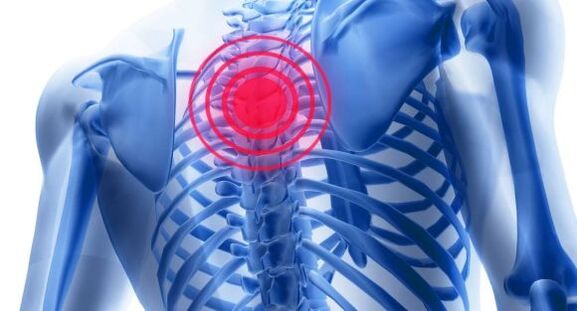
Thorax osteocondrosis- This is a dystrophic change in the intervertebral discs, located in the thoracic back.The treatment of the disease is required to begin immediately after making a diagnosis as the disease can quickly go in a chronic form.
The main symptoms of the disease are the limitation of the mobility of the shoulder band, shortness of breath, abdominal discomfort and chest pain that causes the heart.The danger of the patient is that symptoms of osteocondrosis are often confused with heart -vessel diseases, therefore therapy is performed by the wrong disease.
The causes of osteocondrosis
Thoracic osteochondrosis occurs as a result of pathological changes in the vertebrae and intervertebral discs as well as decreased blood supply and nutrition.In addition, the disease may be caused by deformation of the spine.
Especially often, people suffering in a sedentary position suffer from the symptoms of breast osteocondrosis.Basically, this office workers and students are at different ages.Due to the constant sitting without observing the correct location of the body, the load on the vertebrae significantly increases, causing their deformation.
The basic causes of the disease:
- Increased load on the spine that occurs when you lift weights
- Age -related changes in the body
- Overweight
- Damage to the spinal cord department
- Predisposition at the genetic level
Depending on the symptom stage, it is divided into 2 clinical cases.In the first case, the pain suddenly occurs and has an acute form (the so -called "lateral").In the second case, pain is long and is often accompanied by stiffness in the cervix and the thorax spine.Pain for breast osteochondrosis limits the mobility of the backs and also provokes respiratory distress.
Treatment of osteocondrosis in the thoracic region is performed using complex methods and schemes whose collection depends on the stage of the disease, its course and causes.Only a highly qualified specialist is able to handle this task.
Phases of the disease
The first phaseIt is characterized by the appearance of local pain due to muscle weakness (thoracalgia).In addition, on the first phase there is a tension of the paravertebral muscles on the back, leading to increased pain and limiting the spine.
The second phaseIt is accompanied by an increase in the pain syndrome as the nerve roots are involved in the inflammatory process.Also at this step, protuberances and/or hernias are displayed by intervertebral discs (MPD).
The third phaseIt provides constant pain that occurs in the area with the affected nerve.There is a change in progress, numbness in the limbs, the appearance of headaches, difficulty breathing and heart rhythm failure.This is due to the manifestation of significant deformations of the intervertebral disc and spine.The risk of sequencing increases sharply (sequencing is the separation of hernia and its movement along the spine, which damages nerve roots associated with the spinal cord).And this in 90% of cases leads to surgery.
OnFourth phaseDiseases interfere with the functions of the intervertebral disk.Bone growth of spine begins to connect nearby spine.Osteocondrosis of the spine often causes a violation of the blood supply to the spinal cord.This phase of the disease is the most dangerous as without timely therapy leads to disability.
Treatment
Before continuing treatment, the diagnosis is performed to detect the disease stage (initial, acute or chronic).Depending on the existing symptoms, therapy methods are selected.
Treatment of osteocondrosis in the thorax region is most effective in the initial stages when pathological changes are not so clearly expressed and reversible.
The most important sign that the disease has entered the acute step is incessant painful sensations in;Muscles on the back, chest and spine.At this point in the development of osteocondrosis, the doctor is a priority task of relieving pain.













































